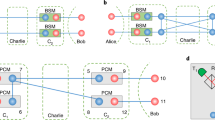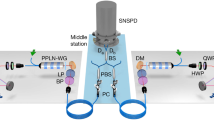Abstract
Quantum repeaters will be critical to quantum communication and quantum computation. Here, we describe a mechanism that permits the creation of entanglement between two qubits, connected by fibre, with probability arbitrarily close to one and in constant time. We show how this mechanism may be extended to ensure that the entanglement has high fidelity without compromising these properties. Finally, we describe how it may be used to construct a quantum repeater that is capable of creating a linear quantum network connecting two distant qubits with high fidelity. The communication rate is shown to be a function of the maximum distance between any two adjacent quantum repeaters rather than of the entire length of the network.
This is a preview of subscription content, access via your institution
Access options
Subscribe to this journal
Receive 12 print issues and online access
$209.00 per year
only $17.42 per issue
Buy this article
- Purchase on Springer Link
- Instant access to full article PDF
Prices may be subject to local taxes which are calculated during checkout



Similar content being viewed by others
References
Nielsen, M. A. & Chuang, I. L. Quantum Computation and Quantum Information (Cambridge Univ. Press, 2000).
Spiller, T. P., Munro, W. J., Barrett, S. D. & Kok, P. An introduction to quantum information processing: applications and realizations. Contemp. Phys. 46, 407–436 (2005).
Dowling, J. P. & Milburn, G. J. Quantum technology: the second quantum revolution. Preprint at http://arxiv.org/abs/quant-ph/0206091 (2002).
Spiller, T. P. & Munro, W. J. Towards a quantum information technology industry. J. Phys.: Condens. Matter 18, 1–10 (2006).
Gisin, N., Ribordy, G., Tittel, W. & Zbinden, H. Quantum cryptography. Rev. Mod. Phys. 74, 145–195 (2002).
Briegel, H.-J., Dür, W., Cirac, J. I. & Zoller, P. Quantum repeaters: the role of imperfect local operations in quantum communication. Phys. Rev. Lett. 81, 5932–5935 (1998).
Dür, W., Briegel, H.-J., Cirac, J. I. & Zoller, P. Quantum repeaters based on entanglement purification. Phys. Rev. A 59, 169–181 (1999).
Sangouard, N., Simon, C., de Riedmatten, H. & Gisin, N. Quantum repeaters based on atomic ensembles and linear optics. Preprint at http://arxiv.org/abs/0906.2699 (2009) and references within.
Van Loock, P. et al. Hybrid quantum repeater using bright coherent light. Phys. Rev. Lett. 96, 240501 (2006).
Ladd, T. D., van Loock P., Nemoto K., Munro W. J. & Yamamoto Y. Hybrid quantum repeater based on dispersive CQED interactions between matter qubits and bright coherent light, New J. Phys. 8, 184 (2006).
Munro, W. J., Van Meter, R., Louis, S. G. R. & Nemoto, K. High-bandwidth hybrid quantum repeater. Phys. Rev. Lett. 101, 040502 (2008).
Van Meter R., Ladd T. D., Munro W. J. & Nemoto K., System design for a long-line quantum Repeater. IEEE/ACM Transactions on Networking 17, 1002–1013 (2009).
Childress, L., Taylor, J. M., Sørensen, A. S. & Lukin, M. D. Fault-tolerant quantum communication based on solid-state photon emitters. Phys. Rev. Lett. 96, 070504 (2006).
Enk, S. J., Cirac, J. I. & Zoller, P. Photonic channels for quantum communication. Science 279, 205–208 (1998).
Duan, L.-M., Lukin, M. D., Cirac, J. I. & Zoller, P. Long-distance quantum communication with atomic ensembles and linear optics. Nature 414, 413–418 (2001).
Zhao, B., Chen, Z.-B., Chen, Y.-A., Schmiedmayer, J. & Pan, J.-W. Robust creation of entanglement between remote memory qubits. Phys. Rev. Lett. 98, 240502 (2007).
Yuan, Z. et al. Experimental demonstration of a BDCZ quantum repeater node. Nature 454, 1098–1101 (2008).
Goebel, A. M. et al. Multistage entanglement swapping. Phys. Rev. Lett. 101, 080403 (2008).
Simon, C. et al. Quantum repeaters with photon pair sources and multimode memories. Phys. Rev. Lett 98, 190503 (2007).
Tittel, W. et al. Photon-echo quantum memory in solid state systems. Laser Photon. Rev. 4, 244–267 (2009).
Sangouard, N., Dubessy, R. & Simon, C. Quantum repeaters based on single trapped ions. Phys. Rev. A 79, 042340 (2009).
Dür, W. & Briegel, H. J. Entanglement purification and quantum error correction. Rep. Prog. Phys. 70, 1381–1424 (2007).
Pan, J.-W., Simon, S., Brukner, C. & Zeilinger, A. Entanglement purification for quantum communication. Nature 410, 1067–1070 (2001).
Bennett, C. H. et al. Teleporting an unknown quantum state via dual classical and Einstein–Podolsky–Rosen channels. Phys. Rev. Lett. 70, 1895–1899 (1993).
Collins, O. A., Jenkins, S. D., Kuzmich, A. & Kennedy, T. A. Multiplexed memory-insensitive quantum repeaters. Phys. Rev. Lett. 98, 060502 (2007).
Gottesman, D. An introduction to quantum error correction and fault-tolerant quantum computation. Preprint at http://arxiv.org/abs/0904.2557 (2009).
Devitt, S. J., Nemoto, K. & Munro, W. J. The idiots guide to quantum error correction. Preprint at http://arxiv.org/abs/0905.2794 (2009).
Jiang, L. et al. Quantum repeater with encoding. Phys. Rev A 79, 032325 (2009).
Steane, A. M. Error correcting codes in quantum theory. Phys. Rev. Lett. 77, 793–797 (1996).
Calderbank, A. R. & Shor, P. W. Good quantum error-correcting codes exist. Phys. Rev. A 54, 1098–1105 (1996).
Steane, A. M. Multiple particle interference and quantum error correction. Proc. R. Soc. Lond. A 452, 2551–2577 (1996).
Knill, E. Quantum computing with realistically noisy devices. Nature 434, 39–44 (2005).
Fowler, A. G. et al. Surface code quantum communication. Phys. Rev. Lett. 104, 180503 (2010).
Perseguers, S. et al. One-shot entanglement generation over long distances in noisy quantum networks. Phys. Rev. A 78, 062324 (2008).
Perseguers, S. Fidelity threshold for long-range entanglement in quantum networks. Phys. Rev. A 81, 012310 (2010).
Bacon, D. Operator quantum error-correcting subsystems for self-correcting quantum memories. Phys. Rev. A 73, 012340 (2006).
Jiang, L., Taylor, J. M. & Lukin, M. D. Fast and robust approach to long-distance quantum communication with atomic ensembles. Phys. Rev. A 76, 012301 (2007).
Aliferis, P. & Cross, A. W. Subsystem fault tolerance with the Bacon-Shor code. Phys. Rev. Lett. 98, 220502 (2007).
Acknowledgements
This work was supported in part by European Union seventh framework projects Hybrid Information Processing (HIP), Quantum Interfaces, Sensors, and Communication based on Entanglement (Q-ESSENCE), a Hewlett Packard Laboratories Innovation Research Grant and Japanese grants from the Specially Promoted Research in Grants-in-Aid for Scientific Research funded by the Ministry of Education, Culture, Sports, Science and Technology (MEXT), the National Institute of Information and Communications Technology (NICT) and the Funding Program for World-Leading Innovative R&D on Science and Technology (FIRST).
Author information
Authors and Affiliations
Contributions
W.J.M., K.A.H. and K.N. conceived the original entanglement-distribution concept. All authors contributed to the final design of the network. W.J.M. and A.M.S. prepared the manuscript with input from S.J.D., K.A.H. and K.N.
Corresponding author
Ethics declarations
Competing interests
The authors declare no competing financial interests.
Supplementary information
Supplementary information
Supplementary information (PDF 212 kb)
Rights and permissions
About this article
Cite this article
Munro, W., Harrison, K., Stephens, A. et al. From quantum multiplexing to high-performance quantum networking. Nature Photon 4, 792–796 (2010). https://doi.org/10.1038/nphoton.2010.213
Received:
Accepted:
Published:
Issue Date:
DOI: https://doi.org/10.1038/nphoton.2010.213
This article is cited by
-
Forty thousand kilometers under quantum protection
Scientific Reports (2023)
-
A quantum router architecture for high-fidelity entanglement flows in quantum networks
npj Quantum Information (2022)
-
Massively-multiplexed generation of Bell-type entanglement using a quantum memory
Communications Physics (2021)
-
Demonstration of entanglement purification and swapping protocol to design quantum repeater in IBM quantum computer
Quantum Information Processing (2019)
-
Perfect quantum multiple-unicast network coding protocol
Quantum Information Processing (2018)



